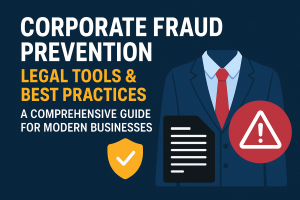Mergers and Acquisitions (M&A) are strategic moves that can redefine the future of businesses. However, behind the scenes of every successful deal lies an intricate process—due diligence—which ensures that both parties have complete clarity on what they’re getting into.
Among the various forms of due diligence, legal due diligence is one of the most critical. It goes far beyond reviewing contracts—it evaluates the legal health of the target company, identifies hidden liabilities, ensures regulatory compliance, and helps the buyer shape the structure, valuation, and risk allocation of the transaction.
What is Legal Due Diligence?
Legal due diligence is a structured and comprehensive review of the legal aspects of a target entity in an M&A transaction. Its core purpose is to:
Identify legal risks and liabilities
Verify title and ownership of assets
Ensure regulatory and statutory compliance
Review pending or potential litigations
Enable informed negotiation and risk mitigation
This process helps buyers uncover any “skeletons in the closet” before making a binding commitment.
Key Legal Risks Identified During Due Diligence
- Corporate Structure and Governance Issues
Inconsistencies in articles of association, shareholding records, or board decisions.
Improperly executed resolutions or approvals.
Non-compliance with Companies Act, 2013 or equivalent foreign statutes.
2. Title to Assets and Intellectual Property
Doubts regarding ownership of physical assets, especially real estate.
IP rights not properly registered, licensed, or under litigation.
Use of third-party software or trademarks without adequate licensing.
3. Contractual Risks
Change-of-control clauses that may result in automatic termination or penalty.
Non-assignment clauses that prevent the buyer from taking over obligations.
Key customer or vendor contracts that are critical to revenue streams but are not legally sound.
4. Litigation and Dispute History
Pending or threatened litigation that could result in financial or reputational loss.
Arbitration awards, unresolved regulatory notices, or labor tribunal cases.
History of regulatory investigations (SEBI, ED, Income Tax Dept., etc.)
5. Regulatory and Statutory Compliance
Licenses and permits under FEMA, FDI policy, environmental laws, or industry-specific regulations.
Compliance with data protection laws (e.g., GDPR, PDP Bill).
History of defaults or penal action by statutory bodies.
6. Labour and Employment Liabilities
Unregistered gratuity, PF, or ESOP schemes.
Undisclosed employee disputes or exit settlements.
Risks from contractual workers, unions, or non-compete claims.
7. Tax Exposure
Tax demands or liabilities not accounted for.
Transfer pricing or GST irregularities.
Discrepancies in filings and audited reports.
Scope of Legal Due Diligence: What to Examine
Corporate Documents (MOA, AOA, resolutions, share certificates)
Material Contracts (vendor, supplier, customer, NDAs)
Licenses, approvals, and permits
Loan and debt documents
Property documents and lease agreements
IP registrations and pending applications
Litigation records and notices
Employee records, contracts, and policies
ESG and CSR obligations
Compliance under SEBI, RBI, FEMA, etc.
Best Practices for Conducting Legal Due Diligence
1. Define Clear Scope and Objectives
Every deal is different. Customise the due diligence checklist based on:
Sector (e.g., fintech, pharma, manufacturing)
Deal size and complexity
Domestic vs. cross-border nature
2. Collaborate Across Functions
Work closely with finance, tax, and technical teams.
Legal issues often overlap with commercial and operational concerns.
3. Identify Red Flags and Deal Breakers
Highlight issues requiring immediate remediation or pricing adjustments.
Recommend specific indemnities or warranties in the SPA.
4. Use Virtual Data Rooms (VDRs)
Helps streamline access to documents and track review status.
Enables smooth collaboration with buyers, advisors, and legal teams.
5. Draft a Detailed Due Diligence Report
Summarize findings with a risk rating matrix (Low, Medium, High).
Recommend specific deal protections, like escrow, earn-outs, or deferred consideration.
Impact of Legal Due Diligence on Deal Structuring
Legal due diligence findings influence the negotiation and execution of:
Share Purchase Agreement (SPA) / Asset Purchase Agreement (APA)
Representations and Warranties
Indemnity Clauses
Escrow or Holdback Provisions
Conditions Precedent (CP) to Closing
Post-deal integration planning
If serious red flags are found, parties may:
Re-negotiate valuation
Seek stronger contractual protections
Delay or abandon the transaction
Conclusion
Legal due diligence is the bedrock of a successful M&A deal. It’s not just about reviewing paperwork—it’s about protecting your investment, ensuring regulatory compliance, and mitigating risk before you take the leap.
A meticulous legal due diligence process helps buyers make informed decisions, avoid future litigation, and structure a deal that is sustainable, compliant, and value-generating.
In a world where M&A is fast-paced and global, having a sharp legal eye during due diligence is not just advisable—it’s essential.



